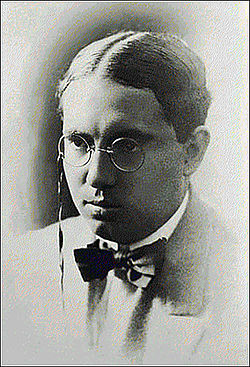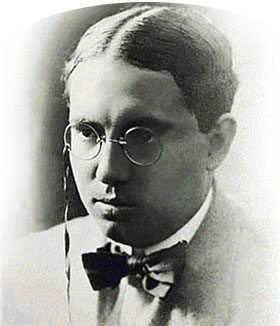Abraham Valdelomar
Abraham Valdelomar (* April 27, 1888 in Ica, Peru, † 1919 in Ayacucho ) was a Peruvian writer and journalist.
Life
Valdelomar Abraham was born on 27 April 1888 in Ica in southern Peru, and died in 1919 in Ayacucho, the provincial capital of the southern Peru Ayacucho region. He was a poet, poet, chronicler, journalist, short story writer and playwright. Valdelomar is considered one of the most important authors of the Peruvian literature of the 20th century. Great authors such as Ricardo Palma or Gonzáles Prada outperformed by its unique individual writing style.
His childhood was spent Valdelomar in Pisco, a port city on the Pacific coast, whose way of life and environment influenced him felt, which was reflected in his poems, as in his fictional prose.
Work
Valdelomar as " escritor Provinciano "
Valdelomar discovered for himself the prevailing modernism in America, a reasoned by Rubén Darío literary movement. During the development of Modernism, however, incompatibilities highlighted in the lifestyle and the writing of the first modernists one hand, they had a clear awareness of their Hispanic-American origin, on the other hand they wanted to write about landscapes and lifestyles that they imagined and not the ones they already knew. Valdelomar was a member of an association of writers that gave the modernist a provincial touch.
He occupied himself with the works of Uruguayan Herrera y Lessing, with Argentinian Lugones and the Peruvian César Vallejo, without ever have direct contact with them.
Valdelomars theme was family life. His famous story " El caballero Carmela " was created, which appeared in his book " El caballero y otros cuentos Carmela " 1918. In this story he describes a rooster standing as a champion in the fight with his cousins. Behind this surface plot intricate family relations and the image of a Peruvian company, slow to develop, but the values of solidarity, cohesion among family members and the distribution of these values maintain among themselves.
Valdelomar as " escritor cosmopolita "
Valdelomars horizon extends beyond the horizon of the small-town, costumbristischer author who is far away from the front work of literature. He is regarded as the champion of cosmopolitanism. He studied at various universities and schools in Guadalupe de Lima and San Marcos. Although he completed no study, developed by university Crusades and work in various newspaper offices, an extraordinary skill.
He let himself get involved in politics, undertook the President Guillermo Billinghurst and in 1912 director of the official newspaper " El Peruano ". In 1913 he became secretary of the Peruvian embassy in Italy. The stay in Italy and European influences were reflected both in his thinking and in his literature.
After his return he planned the establishment of its own cultural magazine, but worked from 1915 as a journalist in the editorial of the newspaper " La Prensa " and wrote mainly parliamentary chronicles of high literary level. During his work in " La Prensa " known intellectuals gathered around him. He published at this time often the pseudonym " El conde de Lemos ". At that time also be José de la Riva Agüero work dedicated to " La Mariscala " and El Caballero Carmelo appeared.
1916 Valdelomar founded the literary magazine " Colónida " in the priority postmodernists a platform for resistance to Riva - Agüero found that championed an unqualified elitist and ideological Hispanismus under rejection of all indigenous elements.
From 1918 undertook Valdelomar numerous tours and attended conferences in the north and south of the country. In 1919 he was appointed representative of the Ica Region in the Congreso Regional del Centro and went to Ayacucho, the seat of his new office. There he suffered as a guest at a gala by a fall a spine fracture and died the following day.
" El Conde de Lemos "
Besides the pseudonym " El Conde de Lemos " he also used the name " Val del Omar ," so as to remember an old Arab. Why Valdelomar used such pseudonyms goes from the literature not clear. High-spirited, agile and extroverted, he lived a public cult of snobbery and scandal. When Mr. an excellent literary inspiration he dipped his works in a wide variety of literary genres.
Genre
Valdelomar developed almost all genres of literature and evaluated in his work the importance of the everyday things, like the home, the province and the peculiarities of the coast. Much of his work is characterized by a soulful, nostalgic and intimate tone. This profiled to a certain degree in the narrative and in the poem Valdelomars. In these he regularly describes family events of his rural childhood village tied to the sea and the countryside of Pisco. The contents territory is rural, provincial and provide a loving, family impression. Formally considered it maintains a sleek, modern writing style with a cosmopolitan influence. This is mainly influenced by the Italian Gabriele D' Annunzio, the Englishman Oscar Wilde and the Spaniard Ramón María del Valle Inclan.
The significance of his postmodernist work is rooted in the representation of provincial innovation. This is becoming the companion of poetry on the coast of Peru. He is also known as the initiator of the " cuento criollo " and revealing biographies, by letting incorporate local themes into the narrative.
His most important works are:
- Narratives: " El Caballero Carmelo ", " Evaristo, el que sauce Murió de amor ", " El hipocampo de oro ", " Los hijos del sol ", " Los ojos de Judas ", " Cuentos Yanquis ", " Cuentos chinos ".
- Poetry: Valdelomar has several individual poems, such as Tristitia, El hermano en la cena ausente pascual, Confiteor y Luna Park. In the poems " Las voces múltiples (1916 ) ," he has compiled several poems themselves.
- Novels: " La ciudad muerta ", " La ciudad de los tísicos ", " yerba santa".
- Essays: " La sicología del Gallinazo ", " Belmonte, el Trágico ", " Con la arge lina al viento ".
- Dramatic literature: " La Mariscala ", " Verdolaga ".
Epochal classification
Together with Enrique Bustamante y Ballivián and José María Eguren represented Abraham Valdelomar a postmodernism, which was to be regarded not only as an aesthetic movement, but rather as " [ ... ] the revision of certain mannerist that have become stylistic method of modernists in the metric or in the area of poetic images ". Formally, the stylistics but not enough to here to distinguish modernism and postmodernism, but a much more important aspect is the content part, because the goal of the modernists is to establish, as in any literary movement, a specific culture of writing with a high recognition value.
Writing style and basic assumptions in factory Valdelomars
Behind the mysteries and questions of man is always the desire for innovation, development and experience of the real meaning of life. But in the life of every living thing there is light and shadow, and thus always remain unanswered questions. Man is born, goes through his psycho- biological existence and dies. This forms a base that is common to all men. He uses his mind and senses to explore the world that surrounds him to classify and above all to understand. The human senses are limited in their nature, but enough to perceive their own complex reality. And yet man its reality often limited himself because he does not know enough to use the spectrum of his senses.
The writing style Valdelomars appears rural and provincial in his stories. Memories of family and childhood are an important part of his work. They lend the stories often have a nostalgic character and emphasize the concept of "home". Abraham Valdelomar selected with preference exotic and exaggerated themes that he prefers designed with a rural charm to pastoral in the form of short stories.
Characteristic of the literature Valdelomars
Swell
- Latin American literary history, Michael Rössner. - 2nd exp. Ed - Stuttgart [ et al ]: Metzler, 2002
- Diccionario manual de literatura peruana y materias Afines, Emilia Romero de Valle. - Lima: Universidad Nacional Mayor de San Marcos, Dep. de Publ, 1966
- Obras; 1, Abraham Valdelomar. - 1988, Valdelomar. Ed. y Prólogo de Luis Alberto Sanchez
- Http://rinconcitoliterario.iespana.es/site/intro/autores/peruana/abrahamvaldelomar.htm
- Http://www.educared.org.pe/estudiantes/literatura/valdelomar1.htm










